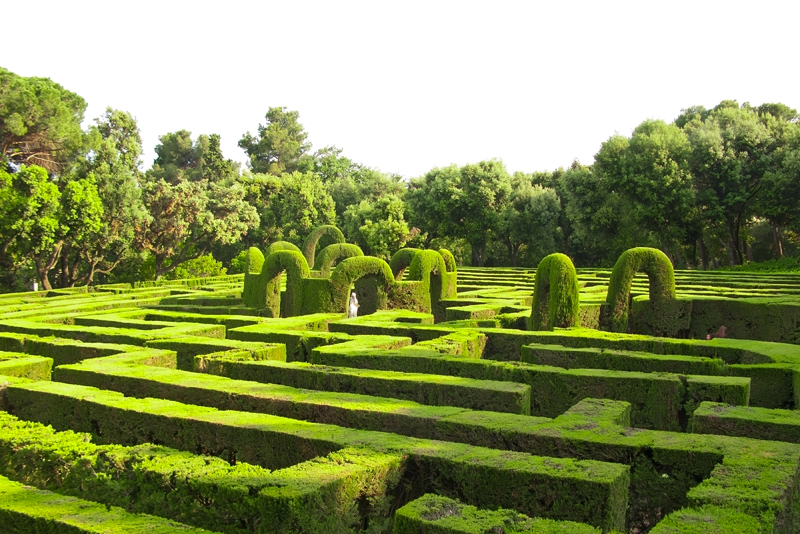English Garden Mazes

Mazes are great fun and there are at least a hundred to visit in England. Long ago, mazes were used as trysting places for lovers. “Meet me in the maze,” your lover might say, and off you’d go.
Don’t underestimate the amount of time you might need to find your way through a maze! Most do have a ‘key’ – a certain way to find your way through to the middle or to the exit. But part of the fun is in getting lost, so don’t worry too much about discovering the ‘key.’
When visiting England, be sure to try any or all of these mazes. Most can be easily reached by train from London.
Hampton Court Palace has the best known and reputedly the oldest hedge maze in England. Planted in the late 17th century from yew, it has nearly a mile of paths. A couple of years ago, they added Elizabethan music and sound effects, which I thought I would hate, but it’s very well done.
Hever Castle has two mazes. Set in the grounds of the childhood home of Anne Boleyn, the hedge maze was built in 1905 by William Waldorf Astor. More recently, they added a water maze. You’re sprayed with water if you take the wrong path! Kids, naturally, love it. The correct path leads you to a high point with a great view of the lake and gardens.
Leeds Castle in Kent is one of my favorites. It is one of the hardest mazes to navigate. Those who are successful will reach a tower where you can wave (and shout directions) to those still trying to find their way. The tower overlooks the vineyard. Then it exits into a wonderful, atmospheric stone grotto.
Longleat House in Wiltshire is the stately home of Lord Bath. The Longleat Maze has over a mile and a half of paths, and 16,000 yews. There are six wooden bridges from which you can look around and try to figure out if you’re anywhere near the middle! This maze has been featured on the BBC’s Animal Planet.
Blenheim Palace, eight miles outside of Oxford, was the birthplace of Winston Churchill. Blenheim features the Marlborough Maze, which has wooden bridges, hidden pavilions, and hedges in the form of symbols such as chess pieces.
A great book on mazes at Amazon:
Don’t underestimate the amount of time you might need to find your way through a maze! Most do have a ‘key’ – a certain way to find your way through to the middle or to the exit. But part of the fun is in getting lost, so don’t worry too much about discovering the ‘key.’
When visiting England, be sure to try any or all of these mazes. Most can be easily reached by train from London.
Hampton Court Palace has the best known and reputedly the oldest hedge maze in England. Planted in the late 17th century from yew, it has nearly a mile of paths. A couple of years ago, they added Elizabethan music and sound effects, which I thought I would hate, but it’s very well done.
Hever Castle has two mazes. Set in the grounds of the childhood home of Anne Boleyn, the hedge maze was built in 1905 by William Waldorf Astor. More recently, they added a water maze. You’re sprayed with water if you take the wrong path! Kids, naturally, love it. The correct path leads you to a high point with a great view of the lake and gardens.
Leeds Castle in Kent is one of my favorites. It is one of the hardest mazes to navigate. Those who are successful will reach a tower where you can wave (and shout directions) to those still trying to find their way. The tower overlooks the vineyard. Then it exits into a wonderful, atmospheric stone grotto.
Longleat House in Wiltshire is the stately home of Lord Bath. The Longleat Maze has over a mile and a half of paths, and 16,000 yews. There are six wooden bridges from which you can look around and try to figure out if you’re anywhere near the middle! This maze has been featured on the BBC’s Animal Planet.
Blenheim Palace, eight miles outside of Oxford, was the birthplace of Winston Churchill. Blenheim features the Marlborough Maze, which has wooden bridges, hidden pavilions, and hedges in the form of symbols such as chess pieces.
A great book on mazes at Amazon:
You Should Also Read:
Hampton Court Palace Garden
Creating a Walled Garden
English Garden History

Related Articles
Editor's Picks Articles
Top Ten Articles
Previous Features
Site Map
Content copyright © 2023 by Carol Chernega. All rights reserved.
This content was written by Carol Chernega. If you wish to use this content in any manner, you need written permission. Contact Carol Chernega for details.


